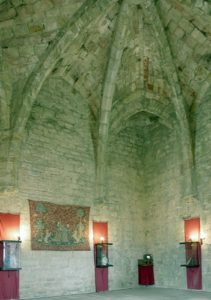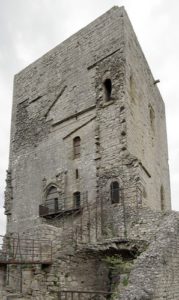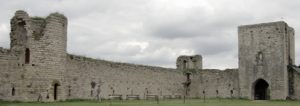The person who told me you could drive to the entrance of the Château lied. Parking is reached off a a signed potholed road from the D117. From there it is a 5 minute walk along a rough track to the entrance. A sign indicated disabled parking up a narrow track which takes you to the castle entrance.
This is one of the best preserved Cathar castles and is best seen from the D117 driving from the west, where the donjon can be seen standing on top of the ridge against the sky. The present building is 13/14thC and was built on the ruins of an 11/12thC castle destroyed by Simon de Montford. In the early 14thC the castle was granted the status of ‘privileged land’. It was exempt from royal taxes as long as it could provide a company of 50 fighting men. It retained this status until the Revolution.
There is a small ticket office in front of the east wall and the remains of two old carts. Entry is through the big square tower in the east wall. This originally had a dry ditch in front of it with a drawbridge. This is now replaced by a bridge and there is the bottom of a modern mock portcullis at the top of the archway. This has heavy wooden doors. There is a small window above and a small crest with the de Bruyère coat of arms. To the north, the curtain wall leads to a round tower. The curtain wall to the south is in poor condition.
Inside the gateway, a wooden ladder leads to accommodation on the first floor. There is a large bailey. This now has a fenced off area used for jousting with a ‘knight’ with shield. Horses graze here. The curtain wall on the north side with narrow arrow slits and a round tower. On the south side is the square Tour Gaillarde. At the far end is the donjon, a massive square building 35m tall. An archway leads to the remains of domestic buildings to the west of the donjon. At the end of the site is the remains of Tour du Treseaux.
A metal bridge and rough stone steps lead up to the first floor of the donjon. Our H&S would have 40 fits if they saw this as there are no safety rails From the doorway, a spiral staircase leads down to the strong room or up to the minstrels room and the roof. Steps are uneven and there is no light apart from a tube with small LED lights on the stair. A second doorway leads into the chapel. This has two windows with stone bench seats. On the wall of one of these is a small exhibition of priest’s vestments, candlesticks and a page from a large hymnal. The tall vaulted ceiling has carved bases with heads holding their hands over their ears. The keystone represents the coronation of Our Lady with St Michael at her feet killing the dragon (Satan). There are two old and rather dusty tapestries on the walls. A stone table altar has been put in at the east end with an old wooden host box which has a tape recorder under it playing music. On the east wall is what is described as a ‘litergical font’ in a carved arch with pillars. This would flow during services.
The spiral staircase leads down to the strong room, where the archives and deeds would be kept safe. Documents were signed here and justice dispensed. It is furnished with a large wooden table and chairs. There are old chests and cupboards. On the walls are metal helmets and wooden shields with crest.s There is a set of chain mail. There are two large topped windows. As the bottoms are below the level of the courtyard, benches are set along steps to give as much light as possible to anyone sitting there.
The Minstrel’s room is on the second floor. This is a huge room with three round topped windows set back in the thick walls with tone benches. It has a high vaulted ceiling with carvings of musicians playing different instruments on the base of the vault pillars. There are small exhibition cases round the walls containing replicas of the medieval instruments. There are three small tapestries on the walls. One shows two women playing a keyboard with a lion and unicorn on either side holding a standard. Another shows a figure playing hand held bagpipes and looking after two sheep with the help of a dog. He is in a wooded setting with trees and wild flowers. The third has a coat of arms with a sheep hanging from the base and a flower background.
The spiral staircase continues up to the roof with a low parapet and good views.
It is rather a strange place and a bit ‘sad’. Someone is trying hard but somehow it doesn’t quite work. Like many ruins, it is better admired from a distance as the inside didn’t live up to the promise. Signs were in French with some information in English, German and Spanish. A sign informs you that the château is privately owned and inhabited. We wondered if this meant the caravan behind the ticket shed…
Location is 5*. The site itself considerably less, possibly only 2*










